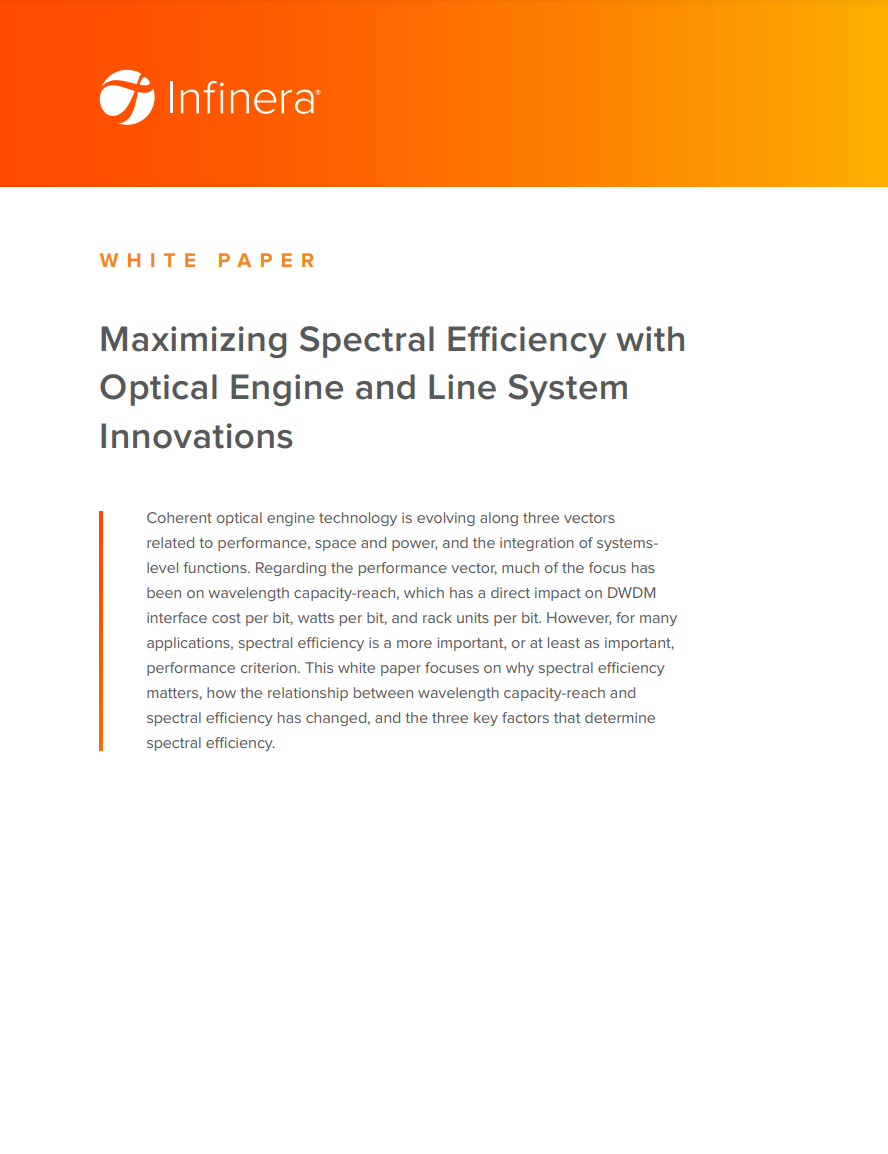Spectral efficiency in communications is the data rate that can be transmitted over a given bandwidth in a communication system. It is expressed as ‘bits-per-second per-hertz, (bits/s/Hz) and can be defined as the net data rate in bits-per-second divided by the bandwidth in hertz.
For years, network operators have invested considerable amounts in fibre. But the Shannon limit dictates that there is a limit to how much data can be transmitted in a given bandwidth – and fibre only has a given amount of spectrum. So, operators wanting to get the most capacity out of that spectrum face a series of decisions and trade-offs.
For example, it’s often prohibitively expensive or simply impossible to lay additional fibre in certain environments. Paul Momtahan, director of solutions marketing at Infinera, explained: ’You can increase the amount of spectrum on the fibre by changing the line system. But that’s disruptive, costly and not always possible if you have a submarine cable, for example. ’The easiest way to increase the spectral capacity of the fibre is to put spectrally-efficient transponders at the end.’
These transponders can optimise two key factors. The first is the ’wavelength capacity reach,’ which is the amount of capacity you can get out of that interface. The second is the ’spectral efficiency,’ which is how many bits-per-second of effective data payload can be transmitted in a given amount of spectrum.
The X-factor
Momtahan continued: ’The industry has primarily focused on wavelength capacity reach. It’s an important aspect, but I’ve always felt that more information is required around spectral efficiency – which is just as important a metric, if not more important – for key applications. For example, in submarine and long-haul networks and for fibre-constrained, high-bandwidth metros, the spectral efficiency is often the most important factor.’
In terms of the trade-offs between the wavelength capacity reach and the spectral efficiency, Momtahan said: ’Primarily, your choice is: do I want to get the maximum amount out of my interface, which reduces cost and power consumption and footprints at the terminal sites, or do I want to get the most out of my fibre? Normally, operators want to combine those two in a way that works for them.’
For example, an operator could lower the modulation but increase the baud rate, which is the rate at which symbols are transferred in a communication channel. But there’s a trade-off there because you also increase the amount of spectrum that you consume by increasing the baud rate.
Alternatively, you could have a large or small gap between the wavelengths. A larger gap means the wavelengths don’t interfere with each other as much, increasing the wavelength capacity reach. A smaller gap reduces the capacity on each individual wavelength but enables more wavelengths and greater total fibre capacity.
There are three, key factors to consider to maximise the spectral efficiency. Momtahan explained: ’To get the most out of the spectral efficiency, operators need to get more bits per Hertz, increase the overhead efficiency, and minimise the amount of spectrum waste.’
Optimisation tools
There are different tools to optimise each of those three things, including the long-codeword probabilistic constellation shaping (LC-PCS), Nyquist subcarriers, and a high modem signal-to-noise ratio (SNR).
Infinera is well-known for its vertically integrated optical engines and coherent transceiver technology that’s developed in-house. ’The optical engine is the brains inside the transponder that generates the wavelength,’ Momtahan explained.
The company has developed the digital signal processors, photonic integrated circuits and other components for these transponders. It has also developed optical line systems, filters, amplifiers and other parts required for terrestrial networks and the endpoints for subsea networks.
Now, we’re getting close to the maximum limit of what can be achieved in terms of spectral efficiency, according to Momtahan, who concluded: ’Maximising spectral efficiency requires both optical engine and line system innovations to optimise these three factors.’
’However, with today’s state-of-the-art optical engines getting close to the (linear) Shannon limit for spectral efficiency, other methods for increasing capacity such as lighting new spectrum bands on existing fibres and space-division multiplexing cable systems, including more fibres per submarine cable and potentially even new multi-core or multi-mode fibres, are likely to become increasingly important.’
For more information about why spectral efficiency matters, how the relationship between wavelength capacity-reach and spectral efficiency has changed, and the three key factors determining spectral efficiency, download the latest white paper.



